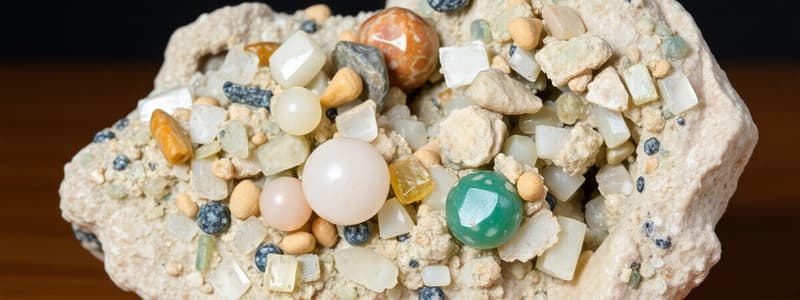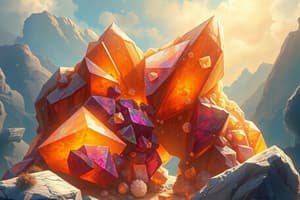Podcast
Questions and Answers
All minerals have the same color.
All minerals have the same color.
False (B)
The way a mineral reflects light is called luster.
The way a mineral reflects light is called luster.
True (A)
Cleavage refers to the way a mineral feels when touched.
Cleavage refers to the way a mineral feels when touched.
False (B)
A mineral with metallic luster looks shiny like a metal.
A mineral with metallic luster looks shiny like a metal.
Streak is always the same color as the mineral.
Streak is always the same color as the mineral.
What is the difference between cleavage and fracture in minerals?
What is the difference between cleavage and fracture in minerals?
Name two tools you can use to test a mineral's hardness.
Name two tools you can use to test a mineral's hardness.
Why is color alone not a reliable property for identifying minerals?
Why is color alone not a reliable property for identifying minerals?
What property is tested by rubbing a mineral on a porcelain tile?
What property is tested by rubbing a mineral on a porcelain tile?
Name three physical properties you can use to identify a mineral.
Name three physical properties you can use to identify a mineral.
Flashcards
Cleavage
Cleavage
How a mineral breaks along smooth, flat surfaces.
Fracture
Fracture
How a mineral breaks along irregular or rough surfaces.
Streak
Streak
The color of a mineral's powder when rubbed against a streak plate.
Luster
Luster
Signup and view all the flashcards
Mohs Hardness Scale
Mohs Hardness Scale
Signup and view all the flashcards
Hardness
Hardness
Signup and view all the flashcards
Color
Color
Signup and view all the flashcards
Mineral
Mineral
Signup and view all the flashcards
Study Notes
Physical Properties of Minerals
- Minerals have various physical properties used to identify them.
- Hardness is measured using the Mohs scale.
- Luster describes how a mineral reflects light.
- Streak refers to the color of a mineral's powder.
- Cleavage describes how a mineral breaks along flat surfaces.
- Color is not always a reliable property, due to impurities.
Identifying Minerals
- Minerals can be identified by testing their physical properties.
- Hardness is tested by scratching a mineral against a known object.
- Luster is observed by how the mineral reflects light.
- Streak is tested by rubbing a mineral across a porcelain tile.
- Cleavage is observed by examining how a mineral breaks.
Studying That Suits You
Use AI to generate personalized quizzes and flashcards to suit your learning preferences.




